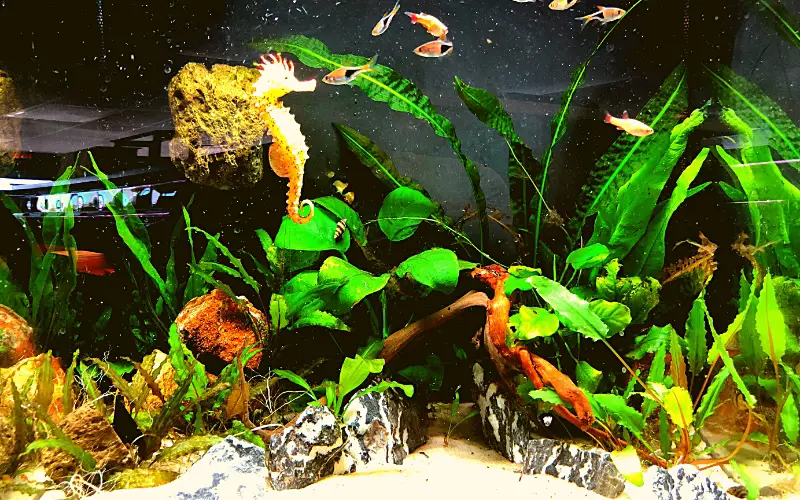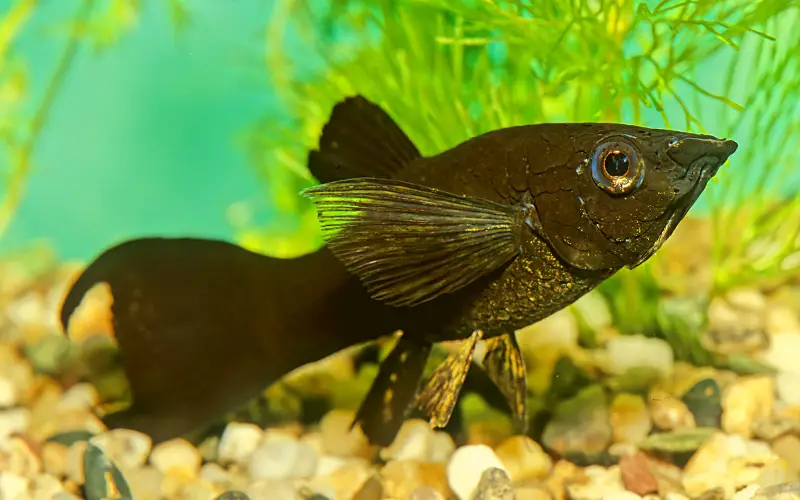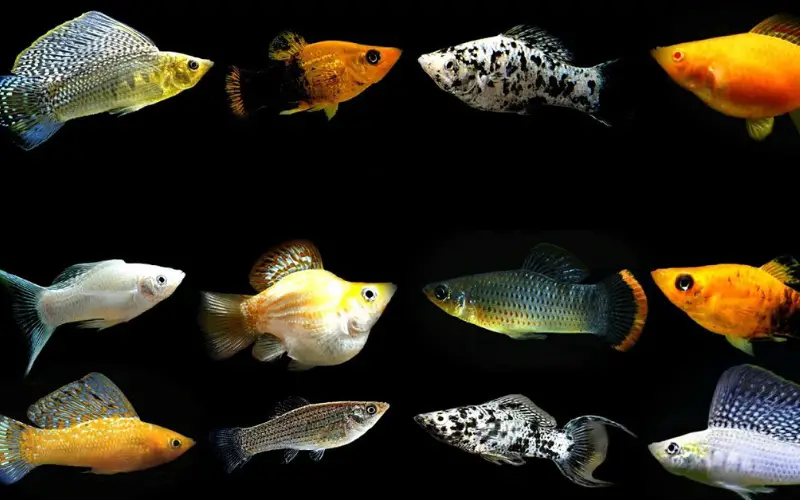Are you looking to learn more about black and yellow molly fish? If so, you’ve come to the right place! One of the most popular freshwater aquarium fish is the Black and Yellow Molly.
These beautiful yellow and black molly fish are hardy and relatively easy to care for, making them excellent choices for even novice aquarists.
In this comprehensive guide, we’ll walk you through everything you need to know about these fascinating creatures – from their size and behavior to what type of molly fish tank setup they will require to grow and thrive.

So, let’s dive into learning all about our friends: These types molly fish black and yellow!
Table of Contents
ToggleWhat Are the Black and Yellow Mollies Called?
The black and yellow mollies are called Gold Dust Mollies. This fish is found in various color combinations, ranging from solid shades of yellow to orange with black-edged fins, often referred to as the ‘Gold Dust’ pattern.
It is a popular aquarium species due to its hardy nature and attractive appearance.
Generally speaking, males have longer dorsal fins than females, and the body coloration of the females tends to be more muted than that of males.
The Gold Dust Molly is not recommended for beginners as it requires higher water temperature and frequent water changes for optimal health.
How Big Do Black and Gold Mollies Get?
Black mollies fish (Poecilia sphenops) and gold mollies (Poecilia latipinna) are popular tropical fish species, often kept in home aquariums.
These two molly species can reach up to 15 cm (6 inches) in length and may grow larger if given the right environment. Generally speaking, both black and gold mollies will reach around 6-15 cm when fully grown.
Although their size is generally the same, there are some differences in coloration.
Both sexes of the black variety have black bodies but may also have white or cream stripes running along their sides and back.
Gold mollies have a more yellowish hue, and males of this species also have greyish spots on their back fins, giving them an attractive appearance.
Both varieties of these fish require clean water with neutral pH levels, as poor water quality can affect their growth rate significantly, leading to stunted development in the long run.
Also, remember that they prefer warm water temperatures ranging from 72°F-82°F, so ensure your tank heater is working correctly before adding any new fish!
Are Gold Dust Molly Aggressive?
No, Gold Dust Mollies fish are not typically aggressive. They are active, playful fish that love to swim around the tank and explore their environment.
Gold Dust Mollies will often dart in and out of plants and like to play with other fish that aren’t too small for them to swallow, but they don’t usually chase or bother other fish.
Because Gold Dust Mollies require plenty of swimming space, it is essential to provide plenty of room for them and create an environment where they can thrive without feeling crowded or threatened by large fish species.
How Long Do Black and Yellow Mollies Live?
Black and yellow mollies are freshwater fish with an average lifespan of 3-4 years but can live up to 5 years in the right environment.
The yellow black molly fish require warm temperatures, oxygen, and clean water to thrive. They typically produce thousands of babies per adult pair each year in their natural habitat.
They also reproduce quickly in captivity, often having multiple broods in one season.
Feeding your mollies a balanced diet of flake food, pellets, brine shrimp, or live molly fish food will ensure they have the nutrients they need to stay healthy and live a long life.
With proper care and maintenance, these attractive fish make famous aquarium inhabitants with their bright black and yellow markings.
How Many Mollies Should You Keep Together?
For the best results, keeping a small group of 5-6 black and yellow mollies in your tank is recommended.
These fish are social creatures and do well in groups; however, it’s important to remember that they can be territorial when kept together in too small of an aquarium.

It is also essential to keep an eye on the size and gender ratio of the group since aggression can occur between different sexes. As a rule of thumb, females should outnumber males.
It is always best to consult a knowledgeable fish store or veterinarian if you are looking for more advice regarding caring for your mollies.
How to Tell If Black and Yellow Molly Fish Pregnant?
Gold dust molly pregnant females will have a swollen abdomen that is more pronounced than usual. In addition, the gravid spot on their bellies will become darker in color, and they may also start to develop black stripes or spots on their bodies.
The female molly fish will also become more active when bred, swimming around the tank and constantly searching for places to hide and rest.
When the female is ready to give birth, she usually takes refuge in a secluded spot within the tank and releases her fry after a few days. If you notice any of these signs, your fish is likely pregnant.
It is also essential to keep up with regular water changes and tank maintenance to ensure that the gravid female and her fry are provided with a healthy environment.
You may also want to consider adding a few live plants to your larger tank, “30 gallon,” as they can provide shading and hiding places for both the female and her fry, ensuring their safety during the birthing process.
By understanding how to properly care for your yellow and black mollies’ fish, you can ensure that they live long and healthy lives. With the right environment and proper diet, Gold Dust Mollies can make great additions to any freshwater aquarium.
Follow these guidelines and tips to give Gold Dust Molly a lovely home!
How to Identify Gold Dust Molly Fish Male and Female?
Black and gold molly fish male or female, can easily be distinguished by their color, size, and shape.
The female molly is usually larger than the male, with an oval-shaped body and a duller coloration.
The males tend to have brighter colors and a slender body shape with a dorsal fin that extends nearly to the end of its tail fin.
It is also possible to determine the gender of your gold dust mollies by examining their genital papilla.
The males have a more pointed shape and longer genital papilla than the females, which tend to be rounder and shorter.
If you are still unsure after examining the fish’s physical characteristics, you can also take a sample of the water and examine it under a microscope to identify the gender.
With some practice, you should easily differentiate male and female mollies, providing them with the best possible care and environment for their health and happiness.
Are Black Mollies Rare?
Black mollies are not considered rare; however, they can be challenging to find in some parts of the world.
These fish thrive in warmer climates and are more common in tropical locations such as South America, Mexico, and Central America.
In addition, black mollies are becoming increasingly popular in the aquarium hobby, so it is essential to be aware of any potential dangers before purchasing a fish.
Always check for signs of disease or stress before buying a molly, and ensure that you provide them with proper care and environment.
Are Black Mollies Aggressive?
Black Mollies can make a serene addition to any freshwater tank, but occasionally battle lines are drawn. Multiple males tend to spar over territory and may harass females if they outnumber them in numbers.

However, as long as the tank’s environment is large enough for all its occupants and there is plenty of cover in the form of rocks and plants, any aggressive behavior should be minimal.
It may also be helpful to add an extra female or two to reduce the aggression levels among male mollies.
Yellow Black Molly Fish Tank Mates:
Yellow and black mollies can be kept with various other species as long as they are tolerant of similar water conditions.
Common molly tank mates for black and yellow mollies include peaceful community fish such as tetras, guppies, platyfish, and danios. Shrimp, snails, and other invertebrates can also make good tankmates.
It is vital to ensure that all the fish in your tank are compatible in size, diet, and temperament. Also, watch for aggression or stress, as some species may not get along with mollies.
By carefully selecting your pet fish tankmates and monitoring them regularly, you can ensure that your molly fish live in a peaceful and healthy environment.
With the right environment and care, black mollies make beautiful additions to any freshwater aquarium.
By understanding how to identify male and female mollies, selecting compatible tank mates, and providing them with the right conditions, you can give your Gold Dust Molly a happy home.
Do Molly Fish Change Colors?
As Molly Fish age, they possess the remarkable ability to adjust their coloration in reaction to environmental changes and stressors.
This vivid species can adapt visually to a range of new conditions through a natural process or release of stress hormones.
When they are in a natural or healthy environment, black mollies have the most vibrant colors, including gold and silver highlights.

When they sense danger or experience stress, they will change to a light gray color as camouflage.
Most molly Fish also change their pattern and intensity of coloration based on age. Juveniles tend to have a lighter coloration with thin black stripes, while adults become darker in color and have thicker stripes.
By providing your mollies with the proper environment and monitoring them regularly, you can ensure they remain vibrant and healthy.
Different Molly Fish Colors: (Mollies Variations by Color)
Different types of molly fishes come in a diverse range of colors and patterns. Common color variations include black mollies, golden sailfin molly, dalmatian lyretail molly, and albino mollies.
- Black Mollies: Black Molly Fish are solid black with a few silver highlights.
- Gold Dust Molly: These mollies are yellow and black with a smattering of gold spots on their fins.
- Dalmatian Molly fish: Dalmatian Mollies have a white base color with small black spots throughout their body and fins.
- Lyretail Molly: Lyretail mollies have long, flowing fins and a bright coloration that ranges from silver to orange and yellow.
- Albino Molly: Albino mollies are solid white with pink or red eyes. They also tend to be more sensitive to changes in water conditions.
Understanding the different color variations allows you to select the molly that best fits your aquarium.
Different Types of Molly Fish: (Molly fish types)
Blue Molly Fish
The blue molly (Poecilia sphenops) is a deep-bodied species with a steel blue coloration and dusky black fins. They are native to the subtropical regions of Central America and can be found in lakes, rivers, and springs.
Orange and Black Molly Fish
The orange and black molly (Poecilia Mexicana) is a vibrant species with bright orange-red bodies and black stripes or spots. They originate from Mexico and can be found in lakes, rivers, and estuaries.
White Molly Fish
The white mollies fish (Poecilia latipinna) is a light-bodied species with an ivory-white coloration and dusky black fins. They are native to Central America, Mexico, and Belize and can be found in reservoirs and slow-moving streams.
Common Black Molly Fish
Common black mollies (Poecilia velifer) are short-bodied species with steel blue coloration and black stripes or spots. They are native to Central America, Mexico, and Venezuela and can be found in lakes, rivers, estuaries, and coastal waters.
Black Sailfin Molly Fish
Black sailfin mollies (Poecilia latipunctata) are a slender-bodied species with dark gray coloration and black stripes. They are native to Central America and can be found in slow-moving streams, lagoons, and estuaries.
Yucatan Lyretail Molly Fish
Yucatan lyretail mollies fish (Poecilia velifera) is a slender-bodied species with silver coloration and black stripes. They are native to Mexico, Belize, and Guatemala and can be found in lagoons, ponds, lakes, and rivers.
Balloon Belly Molly Fish
Balloon mollies (Poecilia Mexicana) are a deep-bodied species with yellow or orange coloration and black stripes. They are native to Mexico and can be found in lakes, rivers, estuaries, and coastal waters.
Black Lyretail Molly Fish
Black lyretail mollies (Poecilia Maculata) are a slender-bodied species with a gray and black coloration. They are native to Central America and can be found in rivers, streams, lagoons, and estuaries.
Gold Doubloon Molly Fish
Gold doubloon mollies (Poecilia Mexicana) are a deep-bodied species with a yellow and black coloration. They are native to Mexico and can be found in lakes, rivers, estuaries, and coastal waters.
Harlequin Sailfin Molly Fish
Harlequin sailfin mollies (Poecilia velifera) is a slender-bodied species with a white and black coloration. They are native to Mexico and can be found in rivers, streams, lagoons, and estuaries.
Marble Lyretail Molly
The Marble Molly Fish is an attractive Black White Molly with rounded heads weighing around five inches in length. It needs tanks larger than 30 gallons with sufficient surface area to develop its large dorsal fin fully. Molly’s marble requires a little salt, so they should only have fish to tolerate their salt content.
Platinum Lyretail Molly
The platinum lyretail molly has a platinum/gold color and a large dorsal fin. The tall fins develop only when there’s sufficient water.
This Platinum Molly is a peaceful molly that requires salt in the water, so they have to stay in water that is sensitive to brackish water. This fish is hardy but slightly more sensitive to temperature changes and pH than many species.
These are just some of the many different types of mollies fish that can add a beautiful and varied look to any aquarium. By selecting the best type of fish for your setup, you can enjoy hours of entertainment as you watch these fascinating creatures go about their day-to-day.
Conclusion
Yellow and black molly fish is a lovable freshwater fish species that make great additions to any aquarium. They’re known for their beautiful black coloration and are relatively easy to care for. Yellow molly fish is similar but has yellow fins and tails instead of black ones. If you want to add color to your aquarium, consider getting some black and yellow molly!
You might also like
- Are Molly Schooling Fish? (9 Compatible Mollies Tank Mates)
- Molly Fish Giving Birth Signs: (5 Symptoms & What to Do)
- 15 Different Types of Mollies to Choose from (Guide)
- Balloon Mollies Fish: The Only Guide You’ll Ever Need (FAQ)
- Dalmatian Lyretail Mollies fish: (Size, Tankmates & Best Diet)
- How Big Can a Black Molly Fish Get: (The Ultimate Guide)
- How Long Do Black Molly Fish Live: (The Shocking Truth)
- What Do Black Molly Fish Eat: 7 Astonishing Black Molly Foods!
- Black Balloon Molly Lyretail 101: a Comprehensive Beginners Guide
- Golden Panda Mollies 101: A Comprehensive (Beginners Guide)
- Gold Doubloon Molly Fish 101: A Comprehensive Beginner Guide




